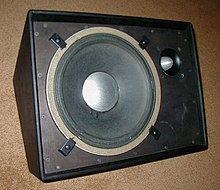
A stage monitor system is a set of performer-facing loudspeakers called monitor speakers, stage monitors, floor monitors, wedges, or foldbacks on stage during live music performances in which a sound reinforcement system is used to amplify a performance for the audience. The monitor system allows musicians to hear themselves and fellow band members clearly.

The sound at popular music and rock music concerts is amplified with power amplifiers through a sound reinforcement system. With the exception of the smallest venues, such as coffeehouses, most mid- to large-sized venues use two sound systems. The main or front-of-house (FOH) system amplifies the onstage sounds for the main audience. The monitor system is driven by a mix separate from the front-of-house system. This mix typically highlights the vocals and acoustic instruments so they can be heard over the electronic instruments and drums.[1][2]
Monitor systems have a range of sizes and complexity. A small pub or nightclub may have a single monitor speaker on stage so that the lead vocalist can hear their singing and the signal for the monitor may be produced on the same mixing console and audio engineer as the front-of-house mix. A stadium rock concert may use a large number of monitor wedges and a separate mixing console and engineer on or beside the stage for the monitors. In the most sophisticated and expensive monitor set-ups, each onstage performer can ask the sound engineer for a separate monitor mix for separate monitors. For example, the lead singer can choose to hear mostly their voice in the monitor in front of them and the guitarist can choose to hear mostly the bassist and drummer in their monitor.
- ^ http://www.sweetwater.com/expert-center/glossary/t--StageMonitor Stage Monitor
- ^ "Taming The Wild Sage Monitor" (PDF). Archived from the original (PDF) on 2011-06-13. Retrieved 2009-01-12.